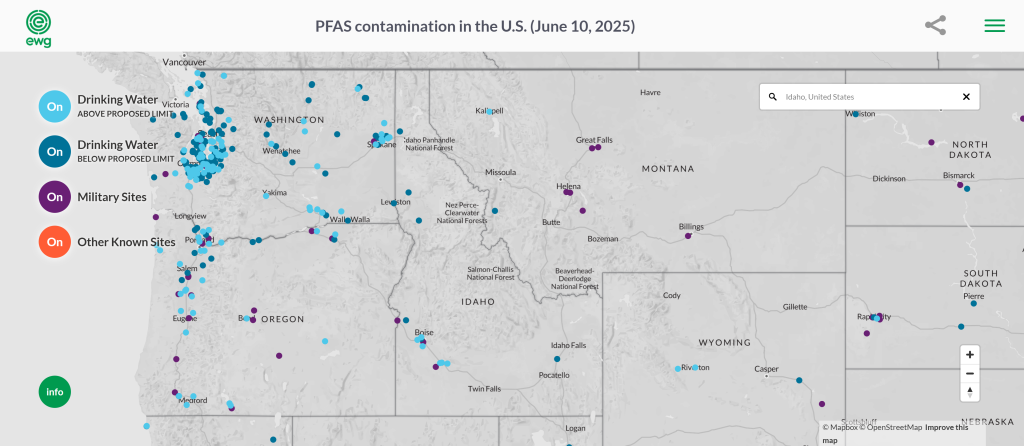PFAS in Idaho
- Last updated: August 11, 2025
-
Contributor: nicky

I began looking into PFAS Idaho issues after learning that per- and polyfluoroalkyl substances (PFAS) can linger in groundwater, soil, and the human body for decades. According to the U.S. Environmental Protection Agency (EPA), even low levels of PFAS pose potential health risks, making it critical for residents to understand how and where these substances occur in Idaho. In the following sections, I will share what makes PFAS dangerous, where contamination has been recorded, and how local and federal agencies are monitoring the situation. I will also offer insight into legal options for those who suspect PFAS-related health or property damage.
What are PFAS and why are they dangerous?
PFAS are synthetic chemicals known for their resistance to heat, water, and oil. They appear in dozens of consumer and industrial products, from firefighting foam to stain-resistant textiles. The CDC’s National Health and Nutrition Examination Survey (NHANES) has found PFAS in the blood of nearly all Americans tested. Two of the most studied PFAS compounds, perfluorooctanoic acid (PFOA) and perfluorooctane sulfonate (PFOS), have been linked to kidney cancer, immune system suppression, and other health concerns.
Researchers from the National Toxicology Program (NTP) concluded that PFOA and PFOS can suppress the antibody response in humans. This finding suggests that high PFAS exposure might compromise an individual’s ability to fight off infections. While large-scale phase-outs have reduced PFOA and PFOS in common products, many other PFAS remain in use, and contamination can persist in the environment for years.
Where are PFAS found in Idaho?
In Idaho, people can encounter PFAS through industrial processes, military bases, landfills, and consumer product disposal. The Idaho Department of Environmental Quality (DEQ) is among several agencies monitoring potential PFAS sources in the state. Although widespread contamination has not been confirmed in all counties, detections have occurred near Mountain Home Air Force Base and Gowen Field Boise/Airport Training Area. Understanding regional hot spots helps focus resources on testing and remediation efforts.
Idaho is hardly unique in facing PFAS contamination. Many states grapple with a similar challenge. For instance, PFAS in Minnesota has also prompted investigations, reflecting the national scope of this concern. In Idaho, municipal and private wells located near industrial sites, fire training grounds, and agricultural operations receive closer scrutiny due to the possibility of leaching or runoff containing PFAS.
PFAS in Idaho’s drinking water
PFAS can reach drinking water through soil infiltration, industrial discharge, and the use of firefighting foams. Once in service lines or public wells, PFAS can remain undetected unless specific testing is performed. The EPA has set a Maximum Contaminant Level (MCL) of 4 parts per trillion (ppt) for PFOA and PFOS in drinking water, though Idaho does not currently include these substances under its primary drinking water regulations.
Known contamination zones
Based on available data, two military facilities in southern Idaho stand out as known contamination zones:
- Mountain Home Air Force Base, where Department of Defense testing confirmed PFAS detections in nearby water sources.
- Gowen Field Boise/Airport Training Area, which reported measurable levels of PFAS during monitoring efforts.
Local residents in these areas frequently rely on private wells, which may not be regularly tested for PFAS. The Idaho DEQ advises routine sampling and collaboration with public health departments if residents suspect possible contamination, especially near known hot spots.
Common PFAS sources: Firefighting foam, military bases, industrial sites
Aqueous film-forming foam (AFFF), widely used in aircraft crash response and large-scale fuel fires, is often implicated in PFAS contamination near military bases. In Idaho, both active and former military installations have used AFFF for training and emergency response. Industrial facilities that manufacture or process PFAS-containing products can also discharge or dispose of these chemicals, allowing them to migrate into groundwater. Although some industrial operations have phased out PFOA and PFOS, many related compounds remain in use.
Idaho DEQ and EPA testing data
The Idaho DEQ participated in the EPA’s Unregulated Contaminant Monitoring Rule (UCMR3) testing between 2013 and 2015. Under this rule, 33 public water systems in Idaho were sampled for PFAS. According to Idaho’s DEQ reports, no PFAS were detected above the method detection limit during that period. However, the absence of high readings in these particular systems does not rule out localized contamination.
Ongoing efforts by the DEQ, alongside EPA interim health advisory levels for PFOA (0.004 ppt) and PFOS (0.02 ppt), guide further study and voluntary sampling. Local authorities suggest that if your water is near a potential industrial or military source, you should consider having it tested.
PFAS in Idaho’s soil and environment
Beyond water, PFAS in Idaho can also accumulate in soil. This can happen when residues from manufacturing, firefighting foam, or consumer products make their way into landfills, then leach into soil over time. Because these substances do not break down easily, contamination often persists, creating a long-term ecological risk.
Contaminated soil from sludge or landfill leachate
Wastewater treatment plants and landfills sometimes distribute treated sludge, also known as biosolids, on agricultural fields. If the sludge contains PFAS, it can lead to contaminated soil. The PFAS can then migrate, entering crops and livestock. According to studies conducted by the EPA, certain PFAS can remain in soil for decades, meaning that one contamination event can have lasting implications.
Potential impact on crops, livestock, and ecosystems
When PFAS accumulate in soil, they may move into plants like alfalfa or corn, which can then be fed to livestock. Over time, this bioaccumulation can affect the broader food chain, potentially leading to low-level exposure for many consumers. Researchers also note that wildlife in affected areas may show elevated PFAS levels, prompting concerns regarding biodiversity, reproduction, and ecosystem resilience.
Health effects of PFAS exposure
Individuals who ingest, inhale, or come into contact with PFAS may experience various health effects, though the degree depends on exposure levels, duration, and personal factors like age or pre-existing health conditions. According to the CDC, PFAS exposure at elevated concentrations may contribute to:
- High cholesterol
- Changes in liver enzymes
- Low infant birth weights
- Elevated risk of kidney and testicular cancer
- Weakened immune response
The link between PFAS and weakened antibodies is particularly concerning for older adults and immunocompromised individuals.
Diseases linked to PFAS in Idaho
Epidemiological studies have explored the connection between PFAS and human disease. Although PFAS contamination in Idaho is relatively less publicized compared to some other states, the state has seen concerning patterns in specific diseases. Researchers recommend continued monitoring as more is learned.
Kidney cancer
On January 26, 2024, the Centers for Disease Control and Prevention (CDC) issued an update highlighting the increased risk of kidney cancer associated with PFAS in Idaho. PFOA, in particular, has been closely associated with renal disease. People living near identified PFAS hotspots or those who have worked in PFAS-related industries may face higher risks, especially if their water supply was contaminated.
Testicular cancer
National research has shown associations between PFAS exposure and testicular cancer, likely due to hormonal disruptions. Although there are fewer data specific to Idaho, experts caution that individuals with occupational exposures should take precautionary measures, including regular health screenings.
Thyroid and liver damage
PFAS can affect endocrine pathways, raising concerns about thyroid issues, especially in women. Idaho has experienced an uptick in thyroid cancer diagnoses near industrial sites, though comprehensive studies on direct PFAS links are ongoing. Additionally, some PFAS can disrupt liver function. When combined with other environmental stressors, even moderate PFAS exposure might contribute to liver damage over time.
Immune system problems
Research by the National Toxicology Program found that PFOA and PFOS have the potential to suppress the immune system. This means the body’s ability to fight off pathogens could be compromised. Residents with chronic illnesses or compromised immunity may be more susceptible to additional health complications if PFAS levels in their environment are elevated.
Reproductive and developmental issues
Some PFAS compounds may interfere with hormone regulation and fetal development. Pregnant women exposed to high PFAS levels risk transferring these chemicals to the fetus through the placenta. Infants can be exposed via breast milk or formula prepared with contaminated water. Using bottled water or alternative sources might help reduce risk for infants in areas where PFAS are detected in water supplies.
How is Idaho responding to PFAS contamination?
Idaho’s response to PFAS contamination includes voluntary sampling programs, coordination with federal agencies, and information campaigns to raise awareness of potential health risks. However, no enforceable PFAS regulations currently exist at the state level.
State and local water testing efforts
The Idaho DEQ received federal grant funds in 2020 to conduct additional sampling of public drinking water systems. This program uses EPA Method 533, which detects short-chain PFAS compounds. Testing began in 2021 and continues as funding allows. Officials encourage private well owners to consider certified lab testing, especially if they live near documented contamination zones.
Federal oversight and funding support
On the federal level, the U.S. EPA has proposed establishing PFAS as regulated contaminants in drinking water nationwide. Although this process is ongoing, interim advisories for PFOA (0.004 ppt) and PFOS (0.02 ppt) are already in place. Idaho follows EPA guidance in its public education campaigns, urging residents to stay informed of potential PFAS exposures. These efforts also tie into a larger government-wide initiative led by the White House to advance clean drinking water and reduce pollutants related to PFAS.
Community education and action
Community awareness plays a key role in Idaho’s approach to PFAS. Public meetings, local news coverage, and health department briefings present verified data and explain testing procedures. Some neighborhoods have formed citizens’ groups that advocate for stricter regulations or more frequent monitoring. Residents are also sharing resources on alternative filtration methods and seeking legal counsel if they believe a polluter is liable for contamination.
Can you test your water or soil for PFAS in Idaho?
Yes. If I lived near a known PFAS Idaho hot spot, I would start by contacting the Idaho DEQ or my local health district for recommendations on certified laboratories. The EPA website also maintains a list of accredited labs that can detect low levels of PFAS in water, soil, and even household dust. Testing fees vary, but it is often less expensive if coordinated through local programs.
When testing soil, consider whether biosolids or industrial runoff might have been applied to your property. Laboratory analysis can reveal whether PFAS levels exceed EPA-recommended thresholds. Once you have the results, you can consult with state or federal agencies to understand mitigation options such as soil remediation or specialized drinking water filters.
Do you qualify for a PFAS lawsuit in Idaho?
If you believe PFAS exposure has harmed your health, property, or both, it may be possible to build a legal claim. Compensation may include medical costs, lost wages, property devaluation, and other damages. Typically, you would need:
- Evidence that water, soil, or air on your property contains PFAS
- A demonstrated link between the contamination and your health issues or property damage
- Documented exposure pathways (e.g., relying on a well that tested above EPA health advisories)
Lawsuits often target chemical manufacturers, industrial plants, or other entities responsible for releasing PFAS. Idaho does not have a statewide PFAS drinking water regulation yet, but if you feel your concerns were ignored or your community was not properly notified, a legal action may still apply.
Why choose Legal Claim Assistant
I have found that PFAS litigation can be complicated, requiring environmental testing, expert witnesses, and a familiarity with emerging scientific studies. Legal Claim Assistant helps you connect with attorneys who focus on PFAS lawsuits, offering a free case review to determine whether you qualify for compensation. Having a knowledgeable team can make the legal process more transparent, especially if multiple parties share liability.
If your drinking water has been compromised, you might also consider reading about your water contamination lawsuit options. Companies like DuPont have faced extensive legal scrutiny for PFAS use, and you can learn more at the DuPont Lawsuit page.
Frequently asked questions (FAQ)
Below are some common questions people ask once they learn about PFAS Idaho contamination. If you have further questions or suspect PFAS has harmed your health or property, consider seeking professional advice or contacting Legal Claim Assistant for a free case review.
Red Hill Bulk Fuel Storage Facility has been linked to multiple leaks of fuel and other substances. Some are concerned that firefighting foam used at or near the site has introduced PFAS into the groundwater. I understand that ongoing lawsuits and investigations aim to uncover the full extent of contamination.
If you live in another state, you might also find PFAS contamination in your area. For instance, you can see ongoing monitoring updates in Minnesota or New York, as PFAS contamination can cross state borders.
Yes. Private landowners can coordinate sampling through accredited labs. The Department of Health also monitors wells and issues environmental action levels. Laboratory analysis is specialized, so you need to confirm the lab can detect PFAS at low levels.
Hawaii incorporates the EPA’s MCLs for six PFAS compounds into its Environmental Action Levels. Public water systems are required to test for regulated PFAS, but unregulated compounds may also be tested if local authorities deem necessary.
Farms located near contaminated irrigation sources, firefighting training sites, or industrial facilities may contain PFAS in soil or groundwater. Root crops and leafy vegetables can absorb PFAS, potentially posing health risks. Farmers or gardeners can perform soil tests if contamination is suspected.
PFAS exposure can lead to immune system impairments, hormone disruption, elevated cholesterol, and in some cases, cancer. According to research from the CDC, PFAS may also affect liver enzymes and have been correlated with specific cancers like kidney and testicular cancer.
Yes, you can potentially seek compensation if you have evidence that PFAS exposure caused illness or property damage. Lawsuits may target polluters, industrial users, or manufacturers of PFAS-containing products. For more details on filing a claim, see the PFAS Lawsuit page.
I have seen people successfully pursue legal actions in other states as well, including PFAS in Minnesota and California, so Hawaii is not alone in dealing with PFAS contamination.
If you need further guidance, you can explore additional information. Checking eligibility early is important, especially if there are statutes of limitations on PFAS claims.
Overview PFAS contamination in the USA
Here you van find the PFAS watercontamination map of the United States. Find, state by state, where water contamination has occurred due to PFAS exposure.
- PFAS in Alabama
- PFAS in Alaska
- PFAS in Arizona
- PFAS in Arkansas
- PFAS in California
- PFAS in Colorado
- PFAS in Connecticut
- PFAS in Delaware
- PFAS in Florida
- PFAS in Georgia
- PFAS in Hawaii
- PFAS in Idaho
- PFAS in Illinois
- PFAS in Indiana
- PFAS in Iowa
- PFAS in Kansas
- PFAS in Kentucky
- PFAS in Louisiana
- PFAS in Maine
- PFAS in Maryland
- PFAS in Massachusetts
- PFAS in Michigan
- PFAS in Minnesota
- PFAS in Mississippi
- PFAS in Missouri
- PFAS in Montana
- PFAS in Nebraska
- PFAS in Nevada
- PFAS in New Hampshire
- PFAS in New Jersey
- PFAS in New Mexico
- PFAS in New York
- PFAS in North Carolina
- PFAS in North Dakota
- PFAS in Ohio
- PFAS in Oklahoma
- PFAS in Oregon
- PFAS in Pennsylvania
- PFAS in Rhode Island
- PFAS in South Carolina
- PFAS in South Dakota
- PFAS in Tennessee
- PFAS in Texas
- PFAS in Utah
- PFAS in Vermont
- PFAS in Virginia
- PFAS in Washington
- PFAS in West Virginia
- PFAS in Wisconsin
- PFAS in Wyoming
Related Article

What Philips CPAP Machines Are Recalled and Why

